You Can Stroke Me Here - But Not There!
Sarah Ellis, International Cat Care
 Cat Behaviorist Sarah Ellis has a pretty cool job. She does research on how and where cats like to be touched. Sarah found that there are certain parts of the cat's body that are better than others when it comes to petting and stroking. She'll reveal her results and explain why she thinks strangers have better luck petting cats than the cat's owner.
Cat Behaviorist Sarah Ellis has a pretty cool job. She does research on how and where cats like to be touched. Sarah found that there are certain parts of the cat's body that are better than others when it comes to petting and stroking. She'll reveal her results and explain why she thinks strangers have better luck petting cats than the cat's owner.
Sarah Ellis, Feline Behavior Expert of International Cat Care, has her own cat at home. Like most cats, her cat likes to be pet in certain places and at certain times.
Sarah had also heard from other people that when they are stroking their cat, suddenly the cat turns and swipes at them. This made Sarah curious, so she teamed up with Katzenworld and conducted a scientific study using 54 cats to look at where cats might like to be stroked.
We already knew that cats like to be stroked, but at some point being stroked, they suddenly don't like it! We really didn't know why.
The first thing Sarah did was to look at where cats make social contact with each other. They tend to rub their faces and heads together. Sometimes they rub their bodies together and sometimes they wrap their tails together.
Next, they looked at where humans touched cats and saw what types of responses they got, and if it was similar to where cats touch each other.
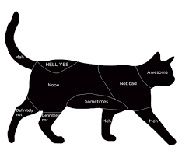 To do the study, they would pet these cats for very short period of times, just seconds, in each body area.
To do the study, they would pet these cats for very short period of times, just seconds, in each body area.
In the first study, they looked at eight different regions on the body. Some of these regions were the scent gland areas where cats produce a chemical known as pheromones. This is the chemical they use to communicate with their own species. When a cat rubs against you, they are actually depositing chemicals on you. But don't worry - you can't smell them!
A cat's scent glands are predominantly in the face. You will find them in the bald patch of hair just in front of the ears, behind their whiskers on their cheeks and under their chin. They are also at the base of their tail.
They compared the areas with scent glands with areas of a cat's body where there aren't any of these glands. This includes along the back, the chest and neck.
What they found was that cats are much more receptive to being stroked in the head area, around the cheeks and under the chin, where the skin is rich in scent glands. They also found out that they really didn't like being touched at the base of their tail.
Often people will run their hand along the head and down the back and then touch the base of their tail. This kind of stroking actually caused a lot of negative behaviors in the cats they studied.
Before they ran their study, they interviewed owners and had them fill out questionnaires online about where they touched their cats. The study was then videotaped so it could be observed and determined what positive and negative reactions the cats were giving. They used an ethogram, which is a behavior categorization.
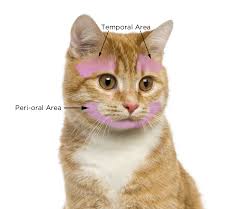 Some of the positive behaviors they observed were slow blinking and kneading with their paws. We already know from science that these signs are indicative of a positive emotional state in cats.
Some of the positive behaviors they observed were slow blinking and kneading with their paws. We already know from science that these signs are indicative of a positive emotional state in cats.
Negative signs were if the cat swiped, or tried to bite or if the cat turned its head around sharply towards the person who was stroking them, or if they just got up and left because they didn't want that interaction to continue.
Your individual results may vary with your own cats. You might have a cat that likes to be stroked by the base of their trail and other areas without scent glands. This could be because you are only touching them there for a short period of time, to which longer exposure might upset them.
But what about the belly? Sarah says they didn't study the belly, because they already know that that is a "No-Go area!"
There is also no known order in which cats likes to be stroked.
Surprisingly, there were more negative responses when the cat's owner touched them as opposed to an unfamiliar person.
http://www.icatcare.org
"Tick Talk"
Doc Halligan, Lucy Pet Foundation
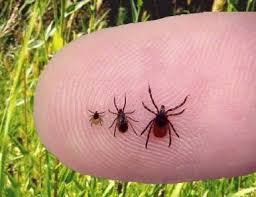 Only second to fleas, ticks are a fairly common pest. Some of the diseases that ticks carry can kill both humans and pets. Doc Halligan will tell you the proper way to remove these nasty pests. She says you need to avoid some of the 'old wives tales' for removing ticks because they may actually do more harm.
Only second to fleas, ticks are a fairly common pest. Some of the diseases that ticks carry can kill both humans and pets. Doc Halligan will tell you the proper way to remove these nasty pests. She says you need to avoid some of the 'old wives tales' for removing ticks because they may actually do more harm.
Ticks are not insects, they're arachnids (like spiders), and are considered ectoparasites, which means they live on the outside of your pet. There are several hundred different species of ticks in the U.S., with the problematic species varying from region to region and can be found in every state. Spring and fall are also the two most active times for ticks; with the most commonly encountered tick is the brown dog tick.
Just like with animals, people can get the same diseases that ticks carry. Your pet can bring them in the house and if they bite a human, that person can also get a deadly disease including the Lyme disease.
Ticks are parasites and spend their entire lives looking for an unwilling host. Ticks don't jump or fly; rather, they position themselves on grass, shrubbery or underbrush so they can hitch a ride with a passing victim and then dig their heads in and start sucking their food of choice: blood. During feeding, ticks can swell up to more than 50 times their normal size and, like fleas, can cause a life-threatening anemia by bleeding their hosts dry. They can also transmit potentially fatal illnesses to your pet.
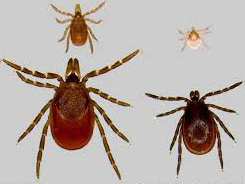 Ticks are most often found in and around the pet's ears, on the belly or on the shoulders, but they can attach anywhere. A tick feeds by burying its head into the host's skin, leaving its body exposed. As it feeds, its body becomes engorged and swollen with blood. Although the body is pretty disgusting, the real danger is the tick's head, which is embedded in the skin. If you remove the tick improperly, you may end up leaving the head behind and putting your pet at risk for infection or abscess. That's why prevention is always the best approach in protecting your pets from ticks.
Ticks are most often found in and around the pet's ears, on the belly or on the shoulders, but they can attach anywhere. A tick feeds by burying its head into the host's skin, leaving its body exposed. As it feeds, its body becomes engorged and swollen with blood. Although the body is pretty disgusting, the real danger is the tick's head, which is embedded in the skin. If you remove the tick improperly, you may end up leaving the head behind and putting your pet at risk for infection or abscess. That's why prevention is always the best approach in protecting your pets from ticks.
If you do see a tick on your pet, you want to remove it pet within 12-24 hours. This is because a tick has a cement-like substance that falls onto your pet, which allows the tick to stick to them. They then bury their heads into your pet's skin (or your skin) and they start drinking blood. If the tick is carrying any type of disease, it will put it into the body it is drinking from within 12-24 hours. The faster it is removed, the greater chance that they have not had the proper time to spread any disease.
There have been many ways over the years to remove ticks, most of them improper. The worst way to remove a tick is to use a match. People have set their pets on fire while doing this. Doc Halligan has removed thousands of ticks and even has a video at her website on how to remove them. She states it's really easy.
To remove them, you should put gloves on to protect your hands if you have a cut so that no fluid from the tick will get on it. Next, take blunted forceps, like tweezers, and put them over the tick's body and go as close to their neck (where the tick is imbedded) as you possibly can. The only part of the tick that is sucking the blood is the head. You want to get as close as you can to the head and then squeeze the tweezers and gently pull up. When they have been removed, make sure you have the head and it is not still in the body of your pet.
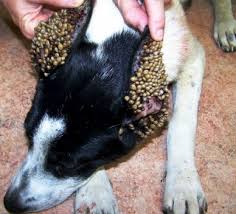 There are many products on the market to help ward off ticks, but there is also a 'tick titer,' which is a blood test performed on your pet's blood serum that measures the production of antibodies against disease-causing organisms transmitted by ticks. The titer will help determine whether your pet has been exposed to a tick-borne disease, and if so, which ones. This is important because there are many different types of organisms that ticks can carry and not all of them spread disease. The three most prevalent diseases that are spread by ticks are Lyme disease, canine ehrlichiosis and Rocky Mountain spotted fever. It takes about 24 to 72 hours for ticks to transfer their diseases, so that gives you time to intervene and remove the tick before it has time to hurt your pet.
There are many products on the market to help ward off ticks, but there is also a 'tick titer,' which is a blood test performed on your pet's blood serum that measures the production of antibodies against disease-causing organisms transmitted by ticks. The titer will help determine whether your pet has been exposed to a tick-borne disease, and if so, which ones. This is important because there are many different types of organisms that ticks can carry and not all of them spread disease. The three most prevalent diseases that are spread by ticks are Lyme disease, canine ehrlichiosis and Rocky Mountain spotted fever. It takes about 24 to 72 hours for ticks to transfer their diseases, so that gives you time to intervene and remove the tick before it has time to hurt your pet.
Tick facts:
- Ticks can transmit many deadly diseases to your pet and family, including Lyme disease, ehrlichiosis and Rocky Mountain spotted fever.
- A female tick can produce up to 20,000 eggs. That's roughly 10 times as many as a flea.
- There are more than 80 species of ticks in the U.S.
- Ticks secrete a cement-like substance to help them stay attached to the host.
- The longer a tick feeds, the greater the risk that it will infect its host with a disease. Removing a tick within 12 to 24 hours after it has begun feeding will reduce the chance of it passing on infectious disease.
- A tick will drink up to 100 times its body weight in blood in one feeding.
- In severe cases of tick infestation, pets can become seriously ill and even die from severe blood loss.
Whenever you take your pet out for a walk, it is best to just run your hands over their bodies to feel for any ticks, which just takes seconds.
The Mission of The Lucy Pet Foundation is to reduce pet overpopulation by having mobile spay/neuter clinics across the country and to support causes that benefit animal welfare. The Lucy Pet Foundation currently has two buses that travel around Southern California focusing on spaying and neutering. These buses are state of the art surgery units. Their next focus is in generating more funds to expand the work of these buses and have more across the country.
 The Lucy Pet Foundation not only offers free and reduced spays and neuters, they also do microchipping, vaccines and de-wormings. Spaying and neutering is not only great for pet population control, but it has been proven that an animal will live on an average of 40-percent longer after having this surgery.
The Lucy Pet Foundation not only offers free and reduced spays and neuters, they also do microchipping, vaccines and de-wormings. Spaying and neutering is not only great for pet population control, but it has been proven that an animal will live on an average of 40-percent longer after having this surgery.
Upcoming Clinics
Free Spay & Neuter for Los Angeles City Residents! Here is a list of upcoming free or reduced fee mobile spay and neuter clinics in California:
Call for more information, questions and to reserve space to get on the list: (855) 499-5829
May 27, 30: Food 4 Less, 1748 West Jefferson Blvd., Los Angeles, CA Spay/Neuter APPOINTMENT ONLY; Vaccine Clinic 10:00am-2:00pm
May 24: Food 4 Less, 5100 N. Figueroa St., Los Angeles, CA Spay/Neuter APPOINTMENT ONLY; Vaccine Clinic 10:00am-2:00pm
May 25: Superior Store, 133 West Avenue 45, Los Angeles, CA Spay/Neuter APPOINTMENT ONLY; Vaccine Clinic 10:00am-2:00pm
May 28, 31: Superior Store Pacoima, 9801 Laurel Canyon Blvd., Pacoima, CA Spay/Neuter APPOINTMENT ONLY; Vaccine Clinic 10:00am-2:00pm
County and City Vouchers accepted. But remember, you must get on a list to have your pet seen at these locations. Please call The Lucy Pet Foundation toll free at 1-855-499-5829 or Email: Info@lucypetfoundation.org to schedule an appointment, or register at the events.
See the current list of clinics at http://www.lucypetfoundation.org.
http://www.lucypetproducts.com
 When Pet Food Is Medicine - Dr. Debbie
When Pet Food Is Medicine - Dr. Debbie
Proper pet nutrition is more than just diet choices for the healthy pet. It's even more important to properly feed the sick pet or those with chronic diseases. What you put in your pet's food bowl can help, or harm, his ability to cope with illness.
Peek into your average veterinary office and you'll likely find one or more brands of therapeutic diet foods created to manage pet specific pet health conditions. Veterinarians prescribe therapeutic diets to help pets with kidney disease, diabetes, pancreatitis, weight loss or heart disease. Special digestive diets may focus on hypoallergenic ingredients, fiber content or fat levels. Some diets prevent or dissolve mineralized stones in the urinary bladder. There are even diets to keep the spring in your arthritic dog's step and diets to aid in treating pets with cancer.
The grandfather of veterinary nutrition was Dr. Morris who in 1940 designed a diet to improve longevity of his dog, Buddy, who was a seeing-eye dog battling kidney disease. His efforts led to the introduction to Hill's K/D diet, a favorite diet used today for dogs and cats with kidney dysfunction. Today many more diets and conditions are addressed by companies such as Science Diet, Royal Canin, Purina and Iams.
As a veterinarian I recognize the value that therapeutic diets lend to managing my patients' health. But my strongest testament to their value is as a doggie momma who feeds a therapeutic diet to my own dog, Magnum.
My Labrador Magnum suffers from food allergies with frequent facial skin infections, bad skin odor, scratching and unpleasant gastrointestinal signs with diarrhea and flatulence. After several diet trials with various hypoallergenic diet approaches, he now thrives on a rabbit based therapeutic diet by Royal Canin. His doggie kisses are sweeter smelling now, he's content and he isn't a walking gaseous explosion anymore.
 But be prepared to dig deeper in your wallet for therapeutic diets. The research behind these foods will cost the consumer more than average pet foods. Just look at the example of Magnum's food. This diet runs $86 for a 25-pound bag of dry food. This sure isn't cheap. But the investment can pay off in lower medical costs and fewer veterinary visits, justifying the additional cost. In Magnum's case, we are able to avoid continued treatment of skin infections, thereby avoiding medication use and he is spared incessant itching.
But be prepared to dig deeper in your wallet for therapeutic diets. The research behind these foods will cost the consumer more than average pet foods. Just look at the example of Magnum's food. This diet runs $86 for a 25-pound bag of dry food. This sure isn't cheap. But the investment can pay off in lower medical costs and fewer veterinary visits, justifying the additional cost. In Magnum's case, we are able to avoid continued treatment of skin infections, thereby avoiding medication use and he is spared incessant itching.
Some pet owners turn to home cooked diets in order to avoid the costs of therapeutic diets. Without guidance and veterinary nutrition analysis, pet owners may risk shortchanging their pet's nutrition. One research study identified that over 90-percent of home prepared diets for sick pets failed to be nutritionally adequate. Quality ingredients aren't cheap and a well-produced home cooked diet often ends up costing far more to prepare than commercially produced therapeutic diets.
If your veterinarian recommends nutritional management with a therapeutic diet, discuss all the options with your doctor. Inquire about different brands and sizes of food packages available, as many options are available. Get your money's worth on these diets by following your veterinarian's recommendations. Avoid mixing therapeutic diets with regular foods. This only hinders your pet's results and give you a false sense of saving money by making the food last longer.
As for Magnum, I choose to feed him his therapeutic diet and avoid popping pills into him. That's my gauge of a therapeutic diet success - food that serves like medicine in the doggie bowl, but without the hassles.
Featured veterinarian known as "Dr. Debbie" on national pet radio program, Animal Radio. Ebook author of "Yorkshire Terriers: How to Be Your Dog's Best Friend"; "Pugs: How to Be Your Dog's Best Friend"; "Mini Schnauzers: How to Be Your Dog's Best Friend"; and "Shih Tzu: How to Be Your Dog's Best Friend."
http://www.drdebbie.net
How Does Cloning Work?
Melain Rodriguez, ViaGen Pets
 The first pet to be cloned on American soil was a success. Now, many people are rushing to genetically preserve their pets' DNA. We'll be talking to the company that clones dogs and cats and find out how it's done and why people want to clone their furry-companions.
The first pet to be cloned on American soil was a success. Now, many people are rushing to genetically preserve their pets' DNA. We'll be talking to the company that clones dogs and cats and find out how it's done and why people want to clone their furry-companions.
The first step to cloning your pet is genetic preservation. Genetic preservation involves a simple skin biopsy performed by your veterinarian using a kit from ViaGen Pets. This biopsy can be done under a local or general anesthetic. The animal heals up very quickly afterwards.
The vet then takes the samples and ships them immediately to the ViaGen Lab where a cell line is cultured from the tissue samples. These cells contain a complete DNA of your pet and those cells are what is the starting point for cloning.
You can stop at this point and keep the cells frozen indefinitely, which can be used for cloning at any time down the road, or you can start the cloning process immediately. There could also be potential therapeutic implications for these cells in the future.
When you're ready for the cloning to begin, ViaGen will take the cells that have grown and they will use these to replace the nucleus of a female's dog eggs. They then have a patented process where the egg and the cell join together and the embryo starts to grow. The embryos are then transferred into a surrogate mother with a normal gestation of about 63 days.
When the puppies or kittens are born, they remain in the care of ViaGen Pets for about 8-12 weeks, and then they are ready to go home to their family.
Melain states that when these animals go home to their families, it is a thrilling event, and like nothing you could imagine. She clams that, "It is just like having your baby back all over again!"
To learn more, please visit ViaGenPets.com or call Melain personally at 1-888-876-6104.
5 Things You Must Know About Pet Bowls
Robert Semrow, Animal Radio Listomania
 When you think about daily interaction with your pets, do you think about your pet bowls? If you don't you should. Pet Bowls are so important to the overall health of your pets we decided to focus on pet bowls this week.
When you think about daily interaction with your pets, do you think about your pet bowls? If you don't you should. Pet Bowls are so important to the overall health of your pets we decided to focus on pet bowls this week.
There are all kinds of bowls on the market these days and they come in all shapes and sizes, made from a variety of materials. Here are 5 things you must know about pet bowls.
Let's start with the material the bowl is made of. From plastic to ceramic to metal to paper, you can find bowls made out of a variety of materials these days. Why does it matter? Well, it matters because each of these has their advantages and disadvantages. Plastic and ceramic bowls can develop scratches, gouges or chips, where bacteria can grow and fester. Metal bowls and silicone bowls require care to be kept clean as well. Paper bowls are single use and effective for germ and cleanliness concerns, but can be more expensive.
I mentioned cleanliness and bacteria because it so important. Studies have shown that E. Coli, Salmonella and yeast or molds are common issues for pet bowls. Your pet's bowl may in fact be a cesspool of germs and bacteria. It is imperative that you clean it after each meal. Add that to the fact that your pet's sense of smell is more than 1,000 times stronger than yours and they may be avoiding their food dish not just out of taste concerns, but health concerns too.
 Next let's talk about the size of the bowl you choose. We have a pet obesity problem and one of the simplest things you can do is select the proper bowl for your pet. If you select a large bowl, that does not mean it needs to be filled beyond the recommendations. Pet parents often see a large bowl as empty and will add more food in. Feeding more food means an obese pet. Get a bowl that holds the proper amount of food.
Next let's talk about the size of the bowl you choose. We have a pet obesity problem and one of the simplest things you can do is select the proper bowl for your pet. If you select a large bowl, that does not mean it needs to be filled beyond the recommendations. Pet parents often see a large bowl as empty and will add more food in. Feeding more food means an obese pet. Get a bowl that holds the proper amount of food.
Remember that your pet may have special bowl needs. Flat-faced pets can have a difficulty with eating out of a normal bowl because of the facial features. There are specifically designed bowl for brachycephalic breeds. If you have a flat-faced pet, this one change can make a world of difference.
Next up cat lovers remember that your cat's whiskers are very sensitive and they don't like it when their whiskers hit the sides of a bowl. So be aware of whisker fatigue and look for a bowl or feeding platform that avoids that issue.
Make them work for it. There are a wide variety of ways and tools to feed your pets with. Switch it up and engage their minds and curiosity with a feeding puzzle or toy that requires them to work for it. They need mental stimulation and will benefit from having to occasionally work to get that reward of food or a treat. There are more of these interactive feeding toys and puzzles and it's a wonderful and healthy break from the norm.
Share your Pet bowl preferences and stories on our Animal Radio Facebook Page.
http://petworldinsider.com
 Animal Radio News - Lori Brooks
Animal Radio News - Lori Brooks
Like A Good Neighbor…
State Farm insurance has been sponsoring The Arson Dog Program since 1993. An accelerant detection canine, or arson dog, is a dog that has been trained to sniff out tiny traces of accelerants that may have been used to start a fire. The insurance giant has had a hand in placing over 350 arson dog teams in 44 states and three Canadian Provinces. All of the K-9s are Labrador Retrievers - for numerous reasons - Labs have a superior ability to discriminate among scents at a fire scene. Their noses can smell parts per quintillion. Labs also generally have a gentle disposition, a 'love to work' attitude, and an outgoing personality. The majority of dogs in the Arson Dog Program are from animal shelters, rescue organizations or are dogs that didn't pass certified companion programs.
Jon Stewart and Steven Colbert Join Forces To Help Animals
 Jon Stewart and Steven Colbert joined forces again this month at the Montclair Film Festival where Stewart introduced the film "Unlocking the Cage." Colbert was on hand to support his wife Evelyn who is a member of the board for the festival. The HBO documentary movie "Unlocking the Cage" follows the story of lawyer Steven Wise who aims to, "Break down the legal wall that separates animals from humans." We've been talking about this a lot lately and this film focuses on the law and how it interprets 'personhood,' a classification even extended to corporations under U.S. law. In the film, which premiered at the 2016 Sundance Film Festival in January, Animal Rights attorney Steven Wise and his legal team argue certain creatures with advanced cognitive capabilities, like chimpanzees, whales, dolphins and elephants, should be provided with certain personhood rights in order to protect them from abuse. The film opens May 25th at Film Forum in NYC before spreading to other cities. If it seems odd that Stewart is spending his retirement introducing animal rights films, you might not have heard about his long-term retirement plans. Stewart's pristine, 12-acre home in New Jersey has been transformed into a farm animal sanctuary.
Jon Stewart and Steven Colbert joined forces again this month at the Montclair Film Festival where Stewart introduced the film "Unlocking the Cage." Colbert was on hand to support his wife Evelyn who is a member of the board for the festival. The HBO documentary movie "Unlocking the Cage" follows the story of lawyer Steven Wise who aims to, "Break down the legal wall that separates animals from humans." We've been talking about this a lot lately and this film focuses on the law and how it interprets 'personhood,' a classification even extended to corporations under U.S. law. In the film, which premiered at the 2016 Sundance Film Festival in January, Animal Rights attorney Steven Wise and his legal team argue certain creatures with advanced cognitive capabilities, like chimpanzees, whales, dolphins and elephants, should be provided with certain personhood rights in order to protect them from abuse. The film opens May 25th at Film Forum in NYC before spreading to other cities. If it seems odd that Stewart is spending his retirement introducing animal rights films, you might not have heard about his long-term retirement plans. Stewart's pristine, 12-acre home in New Jersey has been transformed into a farm animal sanctuary.
 From The Worth Waiting For File
From The Worth Waiting For File
Have you heard about Furbo? It's a multi-tasking camera you can set up in your home or wherever you like to see your pet or even talk to them. You can also trigger it to 'pop' treats remotely for you. Here's how it works: set up is supposed to be super easy and the unit is fastened down with heavy-duty adhesives that come with it so it can't be knocked over. It also has accompanying sounds, lights and a speaker to alert your dog that a treat is on the way. Unlike other devices that silently drop a treat to the floor, Furbo pops the treat across the room to let you and your dog play fetch remotely. Furbo's built-in mic senses barking and immediately sends an alert to your phone that your dog is active. It can be used with cats too. The camera itself is HD, features a wide-angle lens with digital zoom and infrared LED for night vision. The Furbo is available for pre-sale on Indiegogo and is available for pre-order for $99. The first units ship in July.
Pet Population Boom
As we're sure you've noticed, America is experiencing a population boom of pets. Driven by rising disposable income and urbanization and by evolving attitudes toward animals, the number of pets has grown more rapidly since the mid-1970s than the human population, to the point where there are now about as many pets as there are people. Psychologists say the changing way we treat our pets, mostly cats and dogs, is evidence of a deepening 'human-animal bond.' That's the good news. But on the flip side, more and more smaller creatures of all kinds are becoming pets, plucked from their life in the wild to be held captive in a cage. An article in the NY Times recently that focused on this and explored the ways the new era pets are kept and what they really need. For example, goldfish. They are more intelligent than we think, feel pain and engage in socially complex behaviors. But a current trend in aquariums is the so-called nano-tank, a fish habitat designed to fit on the corner of a desk with only 6 cups of water in it. Another interesting point made by the author is the way the pet industry advertises and sells animals, which gives you the impression that these pets themselves are cheap and disposable. Take the case of the pet store in your local mall where for $20 anyone can buy a hermit crab, complete with a cage that would fit on a 5-by-7-inch index card. But, did you know that the recommended size tank for good hermit crab health is at least 10 gallons? Or that hermit crabs, despite their name, are actually social creatures that live in large colonies? Hermit crabs can also live 30 years or longer.
 Spring Means More Visits to the Vet
Spring Means More Visits to the Vet
The fact that those of us who are gardeners are out doing spring planting means veterinarians will soon get more calls about ill pets. Although lilies look beautiful and can smell wonderful, eating just a couple of leaves can cause fatal kidney failure, so be sure to know what kind of lilies grow in your gardens. The more dangerous, potentially fatal lilies are true lilies of the Lilium or Hemerocallis species. Some of these dangerous lilies include the tiger lilies, day lilies, Asiatic hybrid, Easter, Japanese lilies, rubrum, stargazer, red lilies, Western and wood lilies, which all are highly toxic to cats! Calla lilies, peace lilies and lily of the valley are not toxic to the kidney but cause other severe reactions in pets. Sago palms and the Japanese Kungi palm are extremely toxic and should never be in a home with pets or children. The seeds are the most toxic part of the plant and the leaves may also be poisonous. Tulips and hyacinths bulbs, daffodils and crocus can also cause reactions. But it's not just the plants, many of the chemicals gardeners and homeowners use can cause problems for pets, like fish emulsion, blood meal and cocoa mulch all attract pets and have potentially toxic properties. And, of course, lawn chemicals like fertilizers, bug and weed killers can be toxic too, even after it's dried. Your pets walks on the sprayed grass then licks its feet and they just ingested poison. Like you would if you have children, put the number of the animal poison control hotline on your refrigerator so it is there when you need it. ASPCA poison control hotline 1-888-426-4435
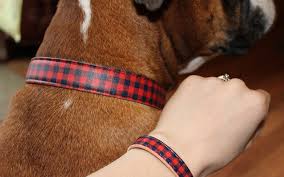 Vegan Accessories For You and Your Pet
Vegan Accessories For You and Your Pet
New York-based Friendship Collar has come up with a super fun idea! The maker of vegan fashion accessories, meaning none of their products are made with any animal component or caused harm to any animal, makes beautiful collars for dogs and cats paired with a matching bracelet for the animal's human! They say, "We wouldn't dream of putting anything on our animals that we would not wear ourselves." In addition, they are all very pretty. All of the friendship collars are softer than leather, durable and most importantly animal friendly. The Friendship Collar won last year's Pet Business Industry Recognition Award for best dog collars. Even better, Friendship Collar is teaming up with rescues and shelters across the U.S. now to help rescue animals around the world find their true best friend and their forever homes.
 Listen to the entire Podcast of this show (#859)
Listen to the entire Podcast of this show (#859)



 Cat Behaviorist Sarah Ellis has a pretty cool job. She does research on how and where cats like to be touched. Sarah found that there are certain parts of the cat's body that are better than others when it comes to petting and stroking. She'll reveal her results and explain why she thinks strangers have better luck petting cats than the cat's owner.
Cat Behaviorist Sarah Ellis has a pretty cool job. She does research on how and where cats like to be touched. Sarah found that there are certain parts of the cat's body that are better than others when it comes to petting and stroking. She'll reveal her results and explain why she thinks strangers have better luck petting cats than the cat's owner. To do the study, they would pet these cats for very short period of times, just seconds, in each body area.
To do the study, they would pet these cats for very short period of times, just seconds, in each body area. Some of the positive behaviors they observed were slow blinking and kneading with their paws. We already know from science that these signs are indicative of a positive emotional state in cats.
Some of the positive behaviors they observed were slow blinking and kneading with their paws. We already know from science that these signs are indicative of a positive emotional state in cats.  Only second to fleas, ticks are a fairly common pest. Some of the diseases that ticks carry can kill both humans and pets. Doc Halligan will tell you the proper way to remove these nasty pests. She says you need to avoid some of the 'old wives tales' for removing ticks because they may actually do more harm.
Only second to fleas, ticks are a fairly common pest. Some of the diseases that ticks carry can kill both humans and pets. Doc Halligan will tell you the proper way to remove these nasty pests. She says you need to avoid some of the 'old wives tales' for removing ticks because they may actually do more harm. Ticks are most often found in and around the pet's ears, on the belly or on the shoulders, but they can attach anywhere. A tick feeds by burying its head into the host's skin, leaving its body exposed. As it feeds, its body becomes engorged and swollen with blood. Although the body is pretty disgusting, the real danger is the tick's head, which is embedded in the skin. If you remove the tick improperly, you may end up leaving the head behind and putting your pet at risk for infection or abscess. That's why prevention is always the best approach in protecting your pets from ticks.
Ticks are most often found in and around the pet's ears, on the belly or on the shoulders, but they can attach anywhere. A tick feeds by burying its head into the host's skin, leaving its body exposed. As it feeds, its body becomes engorged and swollen with blood. Although the body is pretty disgusting, the real danger is the tick's head, which is embedded in the skin. If you remove the tick improperly, you may end up leaving the head behind and putting your pet at risk for infection or abscess. That's why prevention is always the best approach in protecting your pets from ticks.  There are many products on the market to help ward off ticks, but there is also a 'tick titer,' which is a blood test performed on your pet's blood serum that measures the production of antibodies against disease-causing organisms transmitted by ticks. The titer will help determine whether your pet has been exposed to a tick-borne disease, and if so, which ones. This is important because there are many different types of organisms that ticks can carry and not all of them spread disease. The three most prevalent diseases that are spread by ticks are Lyme disease, canine ehrlichiosis and Rocky Mountain spotted fever. It takes about 24 to 72 hours for ticks to transfer their diseases, so that gives you time to intervene and remove the tick before it has time to hurt your pet.
There are many products on the market to help ward off ticks, but there is also a 'tick titer,' which is a blood test performed on your pet's blood serum that measures the production of antibodies against disease-causing organisms transmitted by ticks. The titer will help determine whether your pet has been exposed to a tick-borne disease, and if so, which ones. This is important because there are many different types of organisms that ticks can carry and not all of them spread disease. The three most prevalent diseases that are spread by ticks are Lyme disease, canine ehrlichiosis and Rocky Mountain spotted fever. It takes about 24 to 72 hours for ticks to transfer their diseases, so that gives you time to intervene and remove the tick before it has time to hurt your pet. When Pet Food Is Medicine -
When Pet Food Is Medicine - But be prepared to dig deeper in your wallet for therapeutic diets. The research behind these foods will cost the consumer more than average pet foods. Just look at the example of Magnum's food. This diet runs $86 for a 25-pound bag of dry food. This sure isn't cheap. But the investment can pay off in lower medical costs and fewer veterinary visits, justifying the additional cost. In Magnum's case, we are able to avoid continued treatment of skin infections, thereby avoiding medication use and he is spared incessant itching.
But be prepared to dig deeper in your wallet for therapeutic diets. The research behind these foods will cost the consumer more than average pet foods. Just look at the example of Magnum's food. This diet runs $86 for a 25-pound bag of dry food. This sure isn't cheap. But the investment can pay off in lower medical costs and fewer veterinary visits, justifying the additional cost. In Magnum's case, we are able to avoid continued treatment of skin infections, thereby avoiding medication use and he is spared incessant itching. The first pet to be cloned on American soil was a success. Now, many people are rushing to genetically preserve their pets' DNA. We'll be talking to the company that clones dogs and cats and find out how it's done and why people want to clone their furry-companions.
The first pet to be cloned on American soil was a success. Now, many people are rushing to genetically preserve their pets' DNA. We'll be talking to the company that clones dogs and cats and find out how it's done and why people want to clone their furry-companions. When you think about daily interaction with your pets, do you think about your pet bowls? If you don't you should. Pet Bowls are so important to the overall health of your pets we decided to focus on pet bowls this week.
When you think about daily interaction with your pets, do you think about your pet bowls? If you don't you should. Pet Bowls are so important to the overall health of your pets we decided to focus on pet bowls this week.  Next let's talk about the size of the bowl you choose. We have a pet obesity problem and one of the simplest things you can do is select the proper bowl for your pet. If you select a large bowl, that does not mean it needs to be filled beyond the recommendations. Pet parents often see a large bowl as empty and will add more food in. Feeding more food means an obese pet. Get a bowl that holds the proper amount of food.
Next let's talk about the size of the bowl you choose. We have a pet obesity problem and one of the simplest things you can do is select the proper bowl for your pet. If you select a large bowl, that does not mean it needs to be filled beyond the recommendations. Pet parents often see a large bowl as empty and will add more food in. Feeding more food means an obese pet. Get a bowl that holds the proper amount of food.
 Animal Radio News -
Animal Radio News -  Jon Stewart and Steven Colbert joined forces again this month at the Montclair Film Festival where Stewart introduced the film "Unlocking the Cage." Colbert was on hand to support his wife Evelyn who is a member of the board for the festival. The HBO documentary movie "Unlocking the Cage" follows the story of lawyer Steven Wise who aims to, "Break down the legal wall that separates animals from humans." We've been talking about this a lot lately and this film focuses on the law and how it interprets 'personhood,' a classification even extended to corporations under U.S. law. In the film, which premiered at the 2016 Sundance Film Festival in January, Animal Rights attorney Steven Wise and his legal team argue certain creatures with advanced cognitive capabilities, like chimpanzees, whales, dolphins and elephants, should be provided with certain personhood rights in order to protect them from abuse. The film opens May 25th at Film Forum in NYC before spreading to other cities. If it seems odd that Stewart is spending his retirement introducing animal rights films, you might not have heard about his long-term retirement plans. Stewart's pristine, 12-acre home in New Jersey has been transformed into a farm animal sanctuary.
Jon Stewart and Steven Colbert joined forces again this month at the Montclair Film Festival where Stewart introduced the film "Unlocking the Cage." Colbert was on hand to support his wife Evelyn who is a member of the board for the festival. The HBO documentary movie "Unlocking the Cage" follows the story of lawyer Steven Wise who aims to, "Break down the legal wall that separates animals from humans." We've been talking about this a lot lately and this film focuses on the law and how it interprets 'personhood,' a classification even extended to corporations under U.S. law. In the film, which premiered at the 2016 Sundance Film Festival in January, Animal Rights attorney Steven Wise and his legal team argue certain creatures with advanced cognitive capabilities, like chimpanzees, whales, dolphins and elephants, should be provided with certain personhood rights in order to protect them from abuse. The film opens May 25th at Film Forum in NYC before spreading to other cities. If it seems odd that Stewart is spending his retirement introducing animal rights films, you might not have heard about his long-term retirement plans. Stewart's pristine, 12-acre home in New Jersey has been transformed into a farm animal sanctuary.  Vegan Accessories For You and Your Pet
Vegan Accessories For You and Your Pet